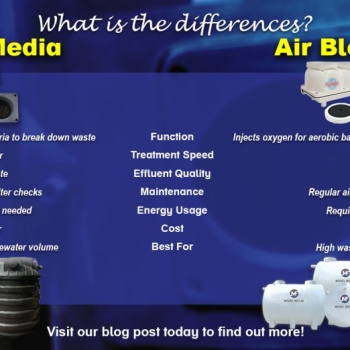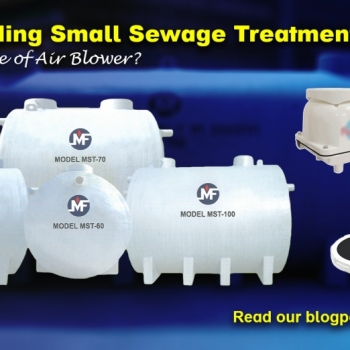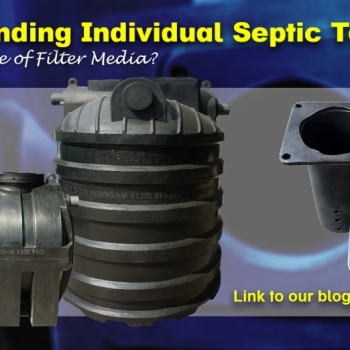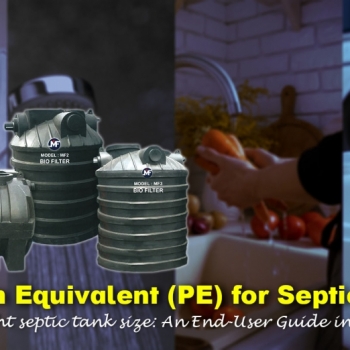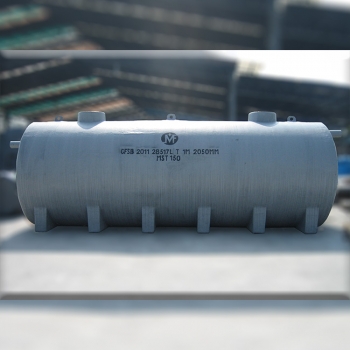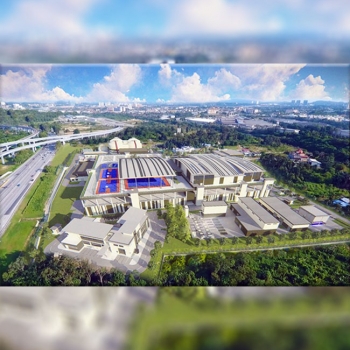Choosing between an individual septic tank with filter media and a mechanical septic tank with an air blower depends on efficiency, cost, and maintenance. This article breaks down their key differences to help you select the right wastewater treatment solution.
Where Should You Place Your Septic Tank? Key Factors to Consider
17 Feb 2025
- Key Takeaways
- Why Septic Tanks Should Not Be Installed Inside a House
- Site Selection for Septic Tanks in Malaysia
- How Septic Tank Placement Affects Wastewater Treatment
- Understanding Your Actual Needs Before Installation
- Choosing the Right Septic Tank
- Frequently Asked Questions (FAQs)
Key Takeaways
-
Septic tanks should not be placed inside a house due to health, ventilation, and maintenance concerns.
-
Poor placement can lead to structural damage, ventilation issues, and difficulty in desludging maintenance.
-
Malaysian regulations require septic tanks to be placed at least 30m away from drinking water sources and in an accessible location for desludging.
-
Individual septic tanks (ISTs) are not connected to centralized sewage treatment plants (STPs) and require proper placement for efficient wastewater flow.
-
Selecting a SIRIM-certified and SPAN-approved septic tank ensures compliance with safety and environmental standards.
Unlike centralized sewer systems, Individual Septic Tanks (IST) are not connected to any sewage treatment plant (STP). Individual septic tanks are prefabricated conventional systems that operate independently and are not subject to billing by Indah Water Konsortium (IWK). These systems are widely used in areas without lateral or network sewer connections. Septic tanks function anaerobically, treating wastewater before discharging the effluent into a nearby drain. The effluent from these tanks flows from the nearest drain into stagnant water bodies, and river streams, and ultimately reaches the sea.
Septic tanks play a crucial role in wastewater treatment. However, improper placement can lead to severe health hazards, structural damage, and costly maintenance. This guide explores why septic tanks should not be placed inside a house, best placement practices, and how compliance with Malaysian regulations can ensure long-term efficiency and safety.
Why Septic Tanks Should Not Be Placed Inside a House
Health and Hygiene Risks
Placing a septic tank inside a house can pose serious health risks. The accumulation of wastewater can release harmful gases, such as methane and hydrogen sulfide, leading to poor indoor air quality and potential respiratory issues. Additionally, leaks or spills can cause bacterial contamination, increasing the risk of infections and disease transmission.
Structural and Ventilation Issues
Septic tanks require proper ventilation to release gases safely. Installing a septic tank indoors can compromise airflow, leading to foul odors and an unsafe environment. Moreover, the weight and moisture from a poorly placed septic system can weaken building foundations, causing long-term structural damage.
Desludging and Maintenance Challenges
Routine desludging is essential to maintain septic system efficiency. If the tank is placed inside a house, accessing it for desludging becomes difficult, leading to system failures or overflow. External placement ensures easy maintenance, prolonging the lifespan of the system.
Site Selection for Septic Tanks in Malaysia
Regulatory Guidelines & Distance Requirements
According to Malaysian Sewerage Industry Guidelines, Volume V(MSIG, Vol 5) septic tanks must be:
-
Within 30m of desludging vehicle access with a minimum road width of 4.5m.
-
At least 0.5m away from the plot boundary.
-
At least 15m away from underground water storage tanks.
-
At least 30m from any drinking water source (wells, rivers, etc.).
-
At least 6m upslope or 3m downslope from swimming or wading pools.
-
In an area not subjected to heavy vehicle loadings or flooding.
Ideal Placement Considerations
-
Externally located within the property boundary.
-
Open space placement for easy desludging.
-
Close to a receiving water course for treated effluent discharge.
-
Preferably at the rear of the property to minimize visual impact.
Septic tanks shall be situated at the rear end of properties to allow for maintenance vehicle movements and to minimize visual impact. However, if this is not possible due to the unavailability of back lane access, it shall be located at the front end.
Where Septic Tanks Should Not Be Installed
-
Under buildings or permanent structures.
-
In areas with high groundwater levels.
-
Locations prone to flooding or traffic load.
-
Near naked flames due to explosion risks.
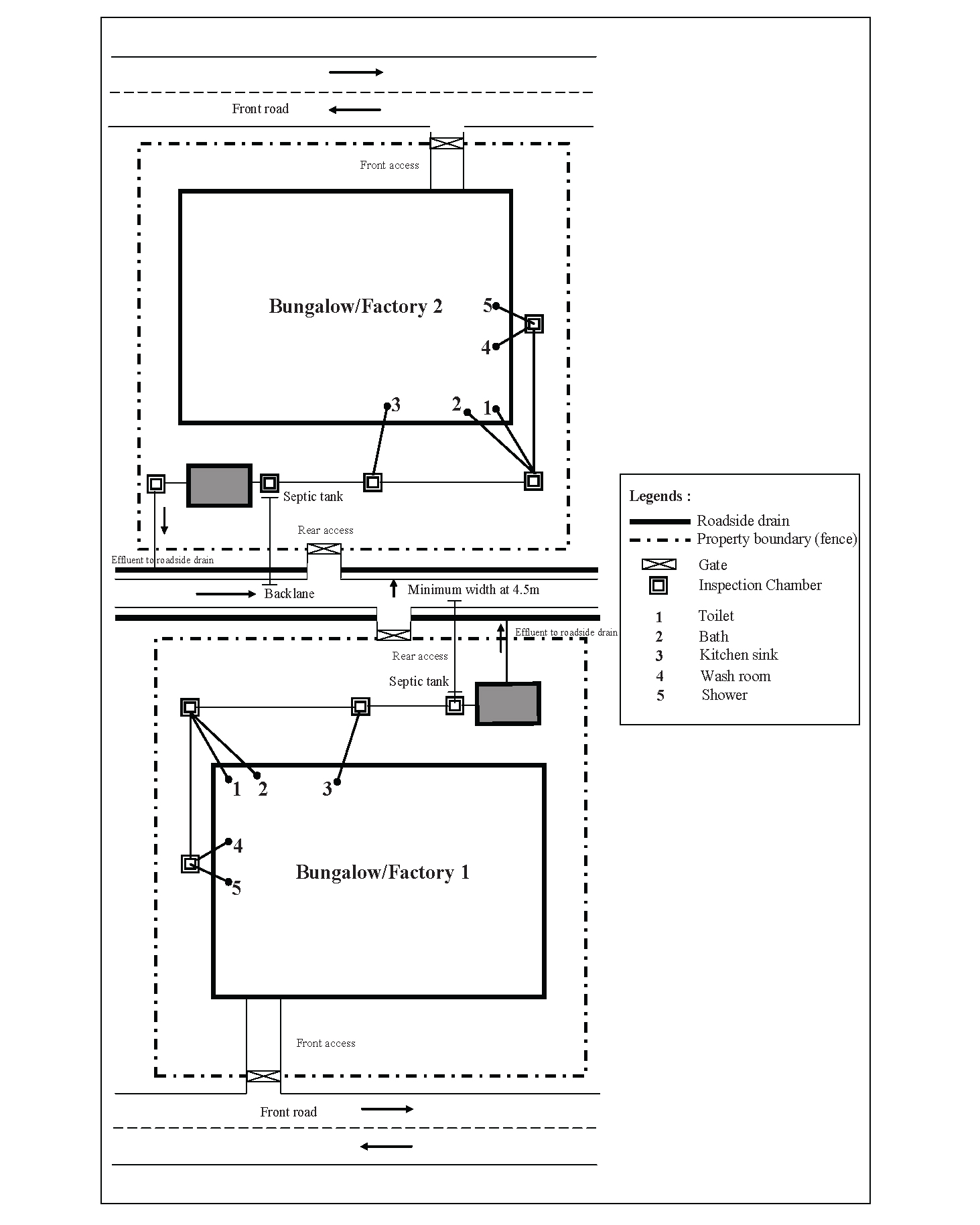
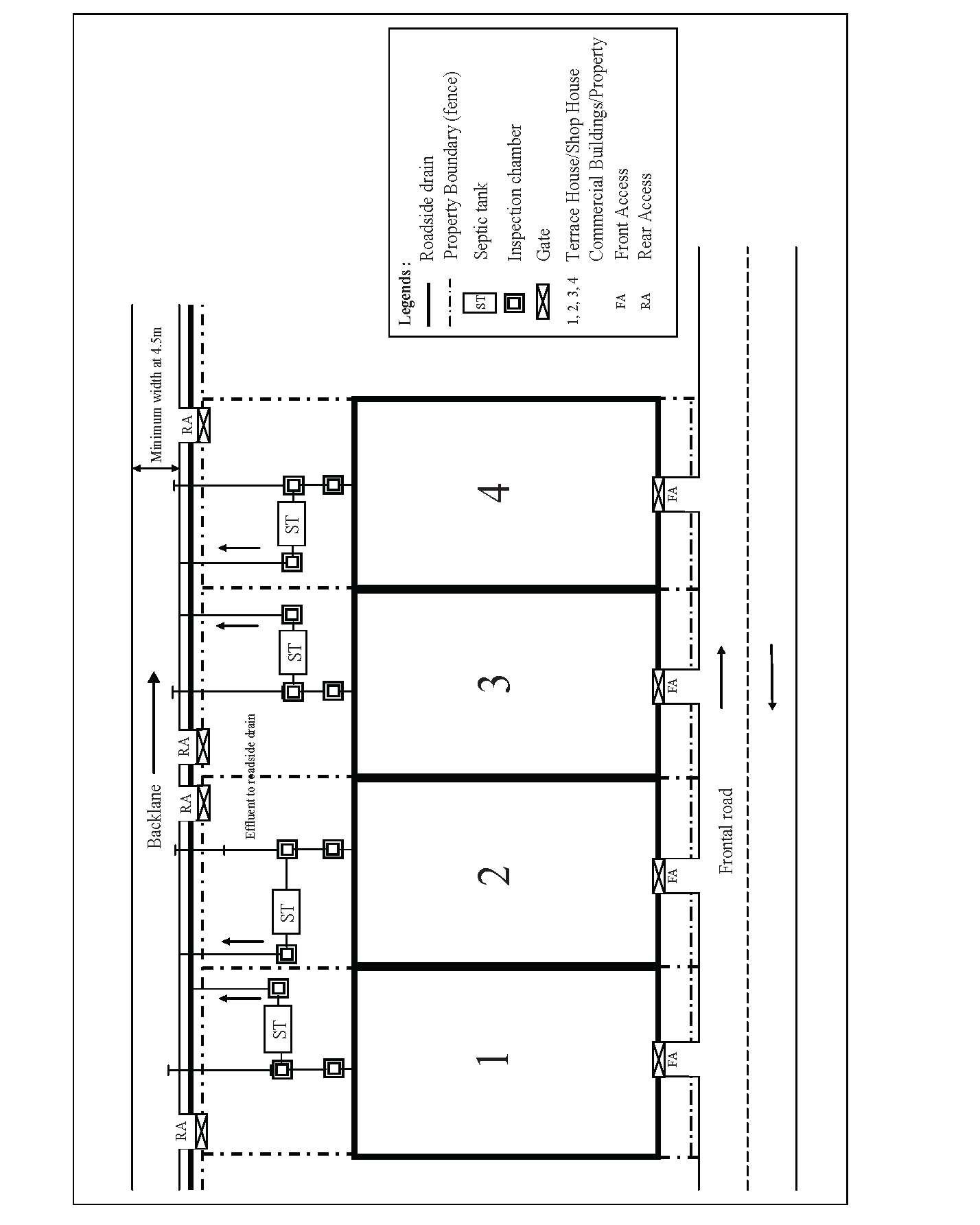
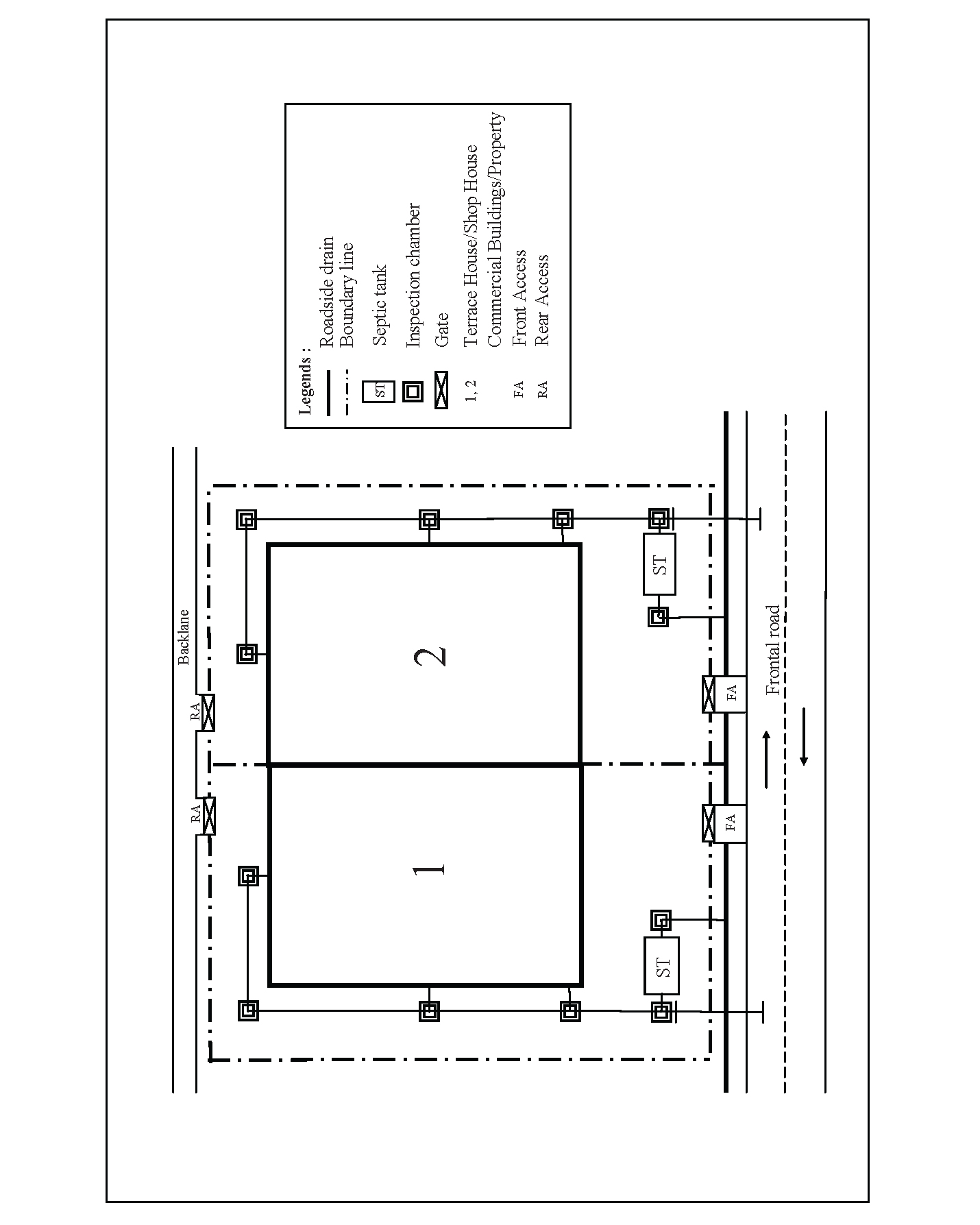 (Illustration layout taken from Malaysian Sewerage Industry Guidelines, Vol 5 (MSIG Jilid V))
(Illustration layout taken from Malaysian Sewerage Industry Guidelines, Vol 5 (MSIG Jilid V))
How Septic Tank Placement Affects Wastewater Treatment
Proper Distance from Water Sources and Structures
Placing septic tanks too close to water sources risks contamination, while placing them too close to buildings may cause structural damage due to leaks or moisture accumulation.
Impact on Wastewater Flow and Maintenance Accessibility
-
Uneven terrain may require costly pumping systems to move wastewater.
-
Poor placement can obstruct desludging, leading to frequent breakdowns.
Understanding Your Actual Needs Before Installation
Before choosing a septic tank location, it is important to assess whether the property is residential or commercial and ensure compliance with local guidelines.
Residential vs. Commercial Septic Tank
| Property Type | Tank Size | Placement Considerations |
|---|---|---|
| Residential | Smaller (5PE/House) | Prioritize accessibility and safety |
| Commercial | Larger (3PE/100m²) | Placement depends on wastewater volume and flow |
-
Residential Properties: Typically require smaller septic tanks with gravity-based flow systems. Placement should prioritize safety and accessibility for desludging. Population Equivalent: 5PE/House
-
Commercial Properties: Due to higher wastewater volumes, commercial septic tanks need to be larger and positioned strategically depending on sizes and nos of storey to handle greater flow rates. Population Equivalent: 3PE/100m Per Gross area
Capacity Requirements (Population Equivalent - PE)
The PE rating determines how many people a septic tank can serve. Under-sizing can lead to overflows, while oversizing increases costs
For more details on Septic Tank Selection, check out our in-depth article Understanding Population Equivalent (PE) for Septic Tanks: An End-User Guide
Regulatory Compliance in Malaysia
In Malaysia, septic tank installations must follow SPAN guidelines to ensure compliance with safety and environmental standards. Failure to adhere to regulations may result in penalties and operational disruptions.
Choose the Right Septic Tank for Your Property
Selecting a high-quality septic tank ensures long-term reliability and efficiency. At Mui Fatt, we manufacture high-quality, SIRIM-certified and SPAN-approved septic tanks for various applications, residential and commercial use. Our products are designed to meet Malaysian safety standards, ensuring long-term performance and environmental sustainability.
Talk to us now via WhatsApp or email at sales@muifatt.com.my to understand more!
Frequently Asked Questions (FAQs)
What is the recommended distance for septic tank placement from a house?
A septic tank should be inside the property boundary but away from permanent structures and traffic load to prevent contamination and structural damage.
How often should a septic tank be desludged?
Every 2-3 years, depending on usage and tank capacity.
For understand more on desludging , check out our in-depth article Why Desludging Your Septic Tank Every 2 Years Matters
What happens if a septic tank is not properly ventilated?
Poor ventilation can lead to gas buildup, resulting in foul odors and potential health hazards.
Can I connect my septic tank directly to a municipal sewer system?
No. Individual septic tanks function independently and are not connected to centralized Sewage Treatment Plants (STPs). Individual septic tanks are considered temporary treatment systems due to their primary treatment capability, serving single development only, and designed for on-site wastewater treatment, with effluent discharge to the nearest drain. In Malaysia, individual septic tank provides future connection pipe laying to the main road for future lateral connection.
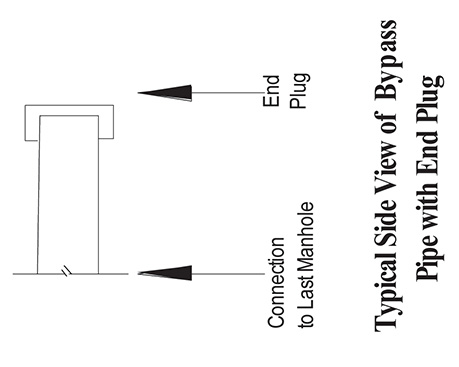
Why choose a SIRIM-certified and SPAN-approved septic tank?
These certifications ensure compliance with Malaysian industry standards, offering durability, efficiency, and environmental protection.
#septictanklocation #septictankplacement #individualseptictank #sewagetreatmentplantconnection #septicsysteminstallation #Malaysiaseptictank #septictankregulations
Disclaimer:-
The content on this site is for general information and entertainment purposes and does not constitute legal counsel. We strive to keep our information as accurate as possible. However, we make no warranties about the completeness, accuracy, reliability, suitability, or availability with respect to the information contained on this page. You should rely on this information at your own risk. This website may include links to other third-party sites. These links are provided as a convenience to you as a reader, user, or browser only. We make no representation, warranty, or guarantee, nor do we endorse or take responsibility for any of the content of such sites.
Stay in touch with us if you’re interested in hearing from us promptly.
- Website - https://www.muifatt.com.my/home/
- Facebook - https://www.facebook.com/muifattmarketing
- Instagram - https://www.instagram.com/muifattmarketing/
- Google - https://goo.gl/maps/WxVY13gNcaRTS7Jp6
- Youtube - http://www.youtube.com/@MuiFattMarketing
- TikTok - https://www.tiktok.com/@muifattmarketing
- LinkedIn - https://www.linkedin.com/company/mui-fatt-marketing-sdn-bhd-
- Linktree - https://linktr.ee/muifattmarketing
- Shopee - https://www.shopee.com.my/muifattmarketing
- Lazada - https://www.lazada.com.my/shop/mui-fatt-marketing
Recent Blog
The Role of Air Blower in Mechanical Septic Tanks
Unlike traditional septic systems, mechanical septic tanks use air blowers to accelerate wastewater treatment. This article explores how air blowers enhance aeration, promote bacterial breakdown, and ensure a more effective sewage treatment system in Malaysia.
The Role of Filter Media in Individual Septic Tanks
Filter media plays a critical role in solid-liquid separation and biological treatment in individual septic tanks. This article explores the importance, types, and benefits of filter media in wastewater treatment, helping you make an informed decision when selecting a septic system in Malaysia.
Simplified IWK Submission Process for Septic Tank Approvals in Malaysia
Navigating the IWK submission process can be challenging. Discover our simplified steps and professional advice for hassle-free septic tank approvals.
Understanding Population Equivalent (PE) for Septic Tanks: An End-User Guide
Discover what Population Equivalent (PE) is and its importance for septic systems, with an easy-to-follow guide for end-users, potential issues of choosing the wrong capacity, and expert tips from Mui Fatt.
Understanding Biodegradable Septic Tanks: A Guide in Malaysia
This article explores biodegradable septic tanks, covering their materials, operations, costs, and maintenance. It also explains why they're rare in Malaysia and introduces alternative sustainable options.
Why Desludging Your Septic Tank Every 2 Years Matters
Regular septic tank desludging ensures efficiency, prevents costly repairs, and protects your environment. Learn the top 10 reasons why this process is critical every two years.
Individual Septic Tanks: A Viable Solution for Rapid Housing Growth in Langat
Discover why individual septic tanks are an ideal solution for new housing developments in areas underserved by the Langat Centralized Sewage Treatment Plant. Learn about their benefits, installation process, and environmental impact.



